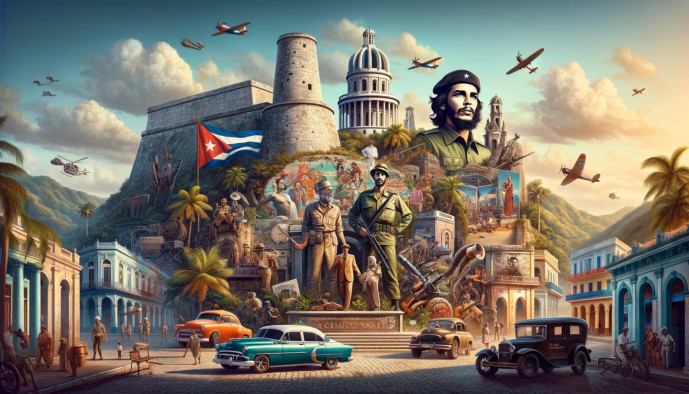Cuba History
Uncover Cuba's history: From colonial rule to the revolution

Pre-Columbian & Colonial Foundations
Indigenous Peoples
Before the arrival of Europeans, Cuba was inhabited by the Taíno and Siboney peoples. While their societies were largely displaced by the Spanish conquest, their legacy endures subtly in the culture and geography of the island. You may hear place names with indigenous roots or see agricultural practices that have been passed down through generations, a quiet echo of the island’s original inhabitants.
Spanish Conquest and Colonization
Christopher Columbus landed in Cuba in 1492, marking the beginning of nearly 400 years of Spanish rule. The Spanish quickly established settlements that grew into key cities, including Baracoa, Havana, and Trinidad. Due to its strategic location, Cuba became a vital hub for the Spanish Empire in the Americas, a final port of call for treasure fleets returning to Europe. As you walk through the cobblestone streets of Old Havana or the preserved plazas of Trinidad, you are witnessing the direct architectural and cultural legacy of this long colonial period.
The Sugar and Slavery Economy
In the 18th and 19th centuries, Cuba’s economy was transformed by the immense profitability of sugar. This “sugar boom” led to the development of vast plantations and, tragically, the mass importation of hundreds of thousands of enslaved Africans to work them. This history is the very foundation of the powerful Afro-Cuban culture you will encounter. It is audible in the complex rhythms of rumba, visible in the syncretic practices of the Santería religion, and felt in the expressive movements of Cuban dance.
The Fight for Independence
Wars Against Spain
The latter half of the 19th century was marked by a fierce struggle for independence from Spain, most notably the Ten Years’ War led by figures like Carlos Manuel de Céspedes. The intellectual and spiritual father of this movement was José Martí, a poet, essayist, and revolutionary. Throughout your travels, you will see monuments and portraits dedicated to José Martí. He is revered with the same deep respect as a founding father, and his ideas remain central to the Cuban national identity.
U.S. Intervention and the Republic
The Cuban struggle for independence culminated in the Spanish-American War in 1898, which ended Spanish colonial rule. However, true independence was complicated by the Platt Amendment, a U.S. decree that granted America the right to intervene in Cuban affairs. The Republic of Cuba was formally established in 1902, but under significant U.S. influence. This period established the complex, often contentious, relationship between the two nations and was also the era when the iconic American classic cars, now a symbol of the island, were first imported in large numbers.
The Cuban Revolution and its Aftermath
Pre-Revolutionary Cuba (1930s-1950s)
Under the rule of dictator Fulgencio Batista, Cuba, and particularly Havana, became a glamorous playground for American tourists, corporations, and organized crime. This era was defined by glittering casinos, lavish nightclubs, and significant American economic dominance. However, this glamorous facade masked deep-seated social inequality and widespread poverty for the majority of Cubans, creating the conditions that fueled the revolutionary movement.
The Rise of Fidel Castro
The discontent with Batista’s regime culminated in the Cuban Revolution, led by Fidel Castro. The movement gained momentum after the 1953 attack on the Moncada Barracks and evolved into a successful guerrilla war waged from the Sierra Maestra mountains, with Che Guevara as a key commander. On January 1, 1959, Batista fled the country, and the revolutionaries took power. This is the single most defining event of modern Cuban history, and the ubiquitous images of Fidel and Che are constant reminders of this transformative moment.
The Cold War and U.S. Embargo
Following the revolution, Castro’s government nationalized U.S.-owned property and businesses, leading to a complete break in diplomatic relations. The island became a focal point of the Cold War, highlighted by the failed CIA-backed Bay of Pigs Invasion in 1961 and the tense Cuban Missile Crisis in 1962. In response, the United States imposed a comprehensive economic embargo, known in Cuba as el bloqueo. This long-standing policy is directly linked to many of the economic realities you will observe, from limited internet access and food rationing to the remarkable ingenuity required in daily life.
Contemporary Cuba: Navigating the Modern World
The “Special Period”
The collapse of the Soviet Union in 1991 was a devastating blow to Cuba, which lost its primary economic benefactor overnight. The ensuing years of extreme economic hardship, known as the “Special Period in Peacetime,” profoundly shaped the Cuba you see today. It forced a turn towards self-reliance, fostered creative solutions to scarcity, and led the government to open the country to international tourism as a new economic lifeline. This era gave rise to the legalization of small-scale private enterprise, including the charming paladares (private family-run restaurants) and casas particulares (private homestays) that are now central to the travel experience.
A Period of Transition
In recent decades, Cuba has been in a state of gradual transition. After Fidel Castro transferred power to his brother Raúl Castro, the government initiated cautious economic reforms, expanding the space for private entrepreneurship (*cuentapropistas*). A historic diplomatic thaw with the United States began in 2014, increasing travel and engagement, though many of these policies were later reversed. Understanding this recent history helps explain the hybrid economy you will encounter, a dynamic mix of state-run enterprises existing alongside a growing and vibrant private sector.